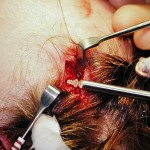
Like laparoscopic abdominal surgery, endoscopic browlifts use a few small incisions in the scalp and rely on releasing the brow and forehead from the bone through the assistance of small cameras and instruments. The actual lifting of the brows is really accomplished by shifting the forehead and scalp backwards, rather than cutting out scalp as in open browlift surgery. An essential part of this ‘scalp shift’ is that it must be held up in place until the tissues heal back down to the bone. Some form of soft tissue suspension or fixation is needed to make endoscopic browlift surgery work.
While there are many touted methods of endoscopic browlift fixation, and they all appear to work reasonably well, I prefer to use a resorbable screw placed into the skull from the small scalp incisions. Onto these screws, the forehead tissue can be sutures up to the screws holding it in place after surgery. Studies have shown that the tissues must be held in place for at least two weeks and preferably up to one month after surgery. These resorbable screws hold their strength out to 6 to 8 weeks, well beyond what is needed to accomplish forehead healing.
I have used these resorbable endobrow screws (Lactosorb) for the past 12 years and find their use quick and secure. In the old days, I used to have to cut threads into the bone to place the screw, but this has been replaced by a push screw several years ago. Patients may feel the screw
heads for a few months after surgery if they push hard enough, but that feeling goes completely away between 4 and 6 months after surgery. While metal screws will work just as well, patients find comfort in knowing that no permanent devices are left behind on their skull.
Dr. Barry Eppley
Indianapolis, Indiana


